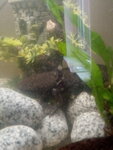A42m
New member
Hi all,
I'm a new owner and I'm seeking advice on a fungal infection. I went to bed last night and woke up to one of my boys (I think) with a white globe around his gills.
I went to my local vet and they advised a salt bath
I joined this board immediately, and have given him one salt bath and I'm about to give him a second now.
I have attatched images below of what I believe is the infection.
If any one has any advice I would love to read it thank you for your time
I'm a new owner and I'm seeking advice on a fungal infection. I went to bed last night and woke up to one of my boys (I think) with a white globe around his gills.
I went to my local vet and they advised a salt bath
I joined this board immediately, and have given him one salt bath and I'm about to give him a second now.
I have attatched images below of what I believe is the infection.
If any one has any advice I would love to read it thank you for your time



